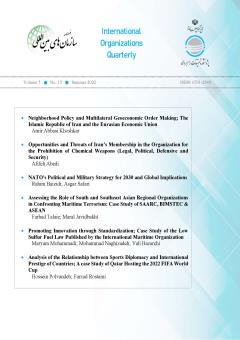-
-
-
Open Access Article
1 - جایگاه سازمان همکاری شانگهای در راهبردهای موازنهجویانۀ منطقهای و فرامنطقهای چین (2020-2010)
Mostafa Pakdel Majd Asghar PirhadiAs an emerging power in the post-Soviet era, the People's Republic of China has experienced an unprecedented upward trend in politics and international relations over the past decade, taking a strategic approach in the form of the Shanghai Cooperation Organization to ex MoreAs an emerging power in the post-Soviet era, the People's Republic of China has experienced an unprecedented upward trend in politics and international relations over the past decade, taking a strategic approach in the form of the Shanghai Cooperation Organization to expand bilateral and multilateral relations with others. In this line, Regional and trans-regional organizations and countries provided PRC with the Suitable foundation for achieving its security, military and economic goals and paved the way for the subsequent rearrangement of the international hierarchy of power. Given the circumstances, based on the theoretical assumptions of the theory of balance of power, with a descriptive-analytical approach, the authors of the present essay have sought to answer this strategic question that "what are the main security goals that Beijing pursues in the form of the Shanghai Cooperation Organization?" The hypothesis of this essay is that through the Shanghai Cooperation Organization, increasing cooperation with the Russian Federation and implementation of Soft aspects of balancing strategy, China is both seeking to limit the active presence of the United States in Central Asia and also dominate this strategic region. Manuscript profile -
Open Access Article
2 - Opportunities and Threats of Iran’s Membership in the Organization for the Prohibition of Chemical Weapons (Legal, Political, Defensive and Security)
Afifeh AbediDue to the proliferation of technologies underlying weapons of mass destruction and the non-membership of Iran's regional rival, Israel, in the organization, and despite the indicators for the success of the Chemical Weapons Convention (CWC) and the Organization for the MoreDue to the proliferation of technologies underlying weapons of mass destruction and the non-membership of Iran's regional rival, Israel, in the organization, and despite the indicators for the success of the Chemical Weapons Convention (CWC) and the Organization for the Prohibition of Chemical Weapons (OPCW), there are always concerns about the consequences of Iran’s membership in the OPCW, meaning that by joining the organization, Iran will not only lose its weapons-based deterrence, but also is exposed to intelligence threats by providing the organization with confidential onformation. The main question of the present study is what legal-political, defense and security opportunities Iran will enjoy and what threats it will face by joining the CWC and the OPCW. The purpose of this research is to accurately explain the opportunities and threats in order to benefit more from them to secure Iran's interests. The findings show that the implicit threats of membership in the CWC and the OPCW are also present in the case of non-membership. However, the direct and implicit opportunities for Iran's membership in the convention and the organization are unavoidable. Manuscript profile -
Open Access Article
3 - NATO's Political and Military Strategy for 2030 and Global Implications
Rahim Baizidi Asgar SafariThe dynamic nature of the international order and distribution of power has transformed the international environment into an arena of rapid political, military, and security developments. The establishment of NATO was also the result of one of these developments, inclu MoreThe dynamic nature of the international order and distribution of power has transformed the international environment into an arena of rapid political, military, and security developments. The establishment of NATO was also the result of one of these developments, including rapid expansion of Soviet's military and geopolitical power. The organization has faced many challenges throughout its life, one of the most important of which was the collapse of the Soviet Union and the disappearance of its founding philosophy. But in the post-Cold War era of international relations, NATO not only sustained its life by relying on its strategic concepts, using Russia's in its domestic power transition, as well as highlighting emerging threats such as terrorism, but also increased its members from 16 countries -before the collapse of the Soviet Union- to 30 countries in 2020. Despite NATO's high level of adaptation to international developments, the global distribution of power is changing rapidly, posing fundamental challenges to the organization. The present study seeks to address three key issues, including the challenges and threats facing NATO in assessing the international political and security environment, NATO's strategy for dealing with these threats, and finally its consequences. Using a descriptive-analytical method, while extracting the system of threats facing NATO, this article deals with some of the most important pillars of NATO's strategy for implementation until 2030. Finally, the global implications of NATO's new strategy are analyzed as well. Manuscript profile
List of Articles تهدید
-
The rights to this website are owned by the Raimag Press Management System.
Copyright © 2017-2024


